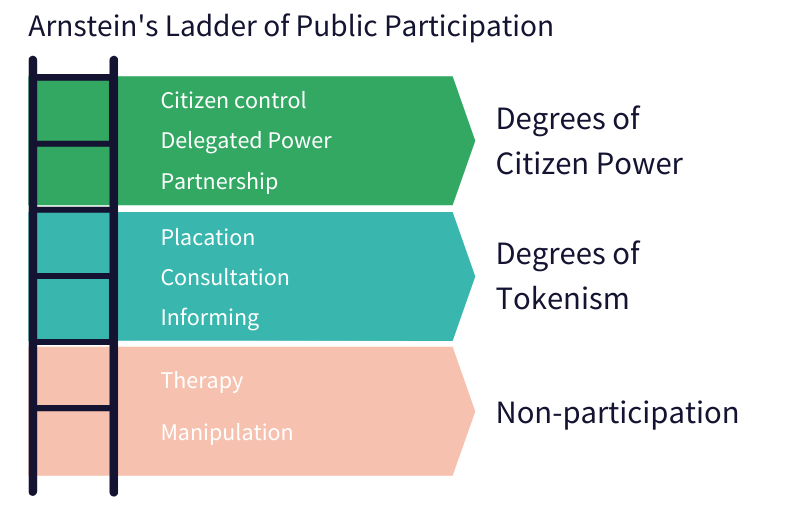Arnstein's Ladder of Citizen Participation explained

By Nouvella Kusi | 25/04/23 08:30
4 min read
Are you in charge of an engagement project but unsure how to ensure it's beneficial for all parties involved? Look no further than Arnstein's Ladder! This principle is a game-changer when it comes to achieving effective citizen participation.
And if you're curious about how we can help you reach that standard, don't hesitate to reach out! We'd be thrilled to chat and even set up a demo for you. Let's make your engagement project a success!
Get started with your next online public engagement project:
Citizen participation is about changing how we, as politicians, developers and citizens, interact with each other to make key decisions. There are many ways for local people to get involved in the decision-making process, and we want to give you some inspiration for what’s already been tried — as well as ideas for where to focus your energy.
Good participation is the basis for a sound democracy. When people get involved in political life, they begin to feel responsible for what goes on around them. Citizen participation in the planning process is much the same; people become invested in the development of their neighbourhoods, heightening a sense of ownership, and will engage for the long haul, building and strengthening trust in the decision-makers over time.
But what does good citizen participation in planning actually look like? It's both a simple and difficult question to answer and this is where many look to Arnstein’s ladder of citizen participation for assistance. So, here’s a (very) brief overview...
What is Arnstein's Ladder?
Arnstein's Ladder is a concept that helps us understand the different levels of citizen participation in decision-making processes. It's like a ladder, with the lowest rungs representing low levels of participation, such as informing or placating citizens, while the highest rungs represent true citizen power, such as a partnership or citizen control.

("A Ladder of Citizen Participation,” Sherry Arnstein, Journal of the American Planning Association)
Think of it this way - imagine you're planning a surprise party. If you only tell your friends about the party but don't ask for their input or involve them in the planning process, that's like the lowest rung on the ladder - informing. But if you actively involve them in the planning, ask for their opinions, and give them a say in the decision-making, that's like the highest rung on the ladder - citizen control.
Arnstein's Ladder helps us understand the importance of moving up the ladder and increasing citizen participation to ensure that everyone's voices are heard and their needs are met.
It’s clear from Arnstein’s writings that Citizen Control is considered the optimum level of participation. We are, of course, advocates of the collaborative approach, but what can’t be overlooked is the fact that citizen engagement is nuanced, and what works for a coastal community in Dorset may not be the best strategy for a citywide engagement in Birmingham. Ultimately, we're aware that the topmost levels of the ladder, ‘Delegation’ or ‘Citizen Control’, are valuable but aren’t always realistic or appropriate for all parties.
So, what is the answer?
An Engagement Framework - Minimum/Good Standard
Well, we got thinking about the numerous engagement projects our platform has facilitated, as well as collaborative works we’ve participated in with Government organisations, and have developed a framework for good engagement. This includes what we deem to be an effective minimum standard of engagement. Our data shows that 71% of people expect to be regularly updated about planning issues in their local area, and we've figured out what this expectation looks like:
- Accessibility - involving the use of a mix of channels, tailored to the community in question, with the appropriate objectives and content set.
- Transparency - making sufficient information readily available, with the scope of influence and process clearly and publicly stated from the outset of the project, using accessible language.
- Timing and process - presenting a statement of community need, ensuring that the process is iterative to produce better results, and delivered in a timely manner.
So now we have a summary of what good citizen participation looks like...
What does good practice Engagement look like?
Our case studies show that when the above ingredients are well combined to create an unbeatable community engagement strategy, the outcome is strengthened, valuable citizen participation; our customer Lewisham Council, and their award-winning engagement for Catford Town Centre, is one of many examples demonstrating this. This type of engagement can be measured by the following:
Influence
The proof has always been in the pudding, this is why our standards suggest that design decisions should be based on the scope of influence had by community feedback. If we were to take this step further, good engagement would ensure that a deliberative and iterative process took place, ensuring the influence had by citizens reached all aspects of the decision-making process, extending as far as the selection of architects and contractors.
Representation
When it comes to representation, it’s important to ensure that the breadth of the community has been accounted for. At the very least, it should be evident that efforts were made to engage the ‘harder to reach’, as well as minority groups in the community. To meet the standard for good citizen participation, we feel it’s important that respondents make up a fully representative sample of the community, not only this, but that strides are taken to achieve the national benchmark scores for representation.
Quality
This could be measured in a number of ways, but in essence, the citizen experience is likely to be the best indicator of good quality engagement, therefore efforts should be made to gain that feedback. the minimum standard here involves all respondents being asked how they feel about the process, with the results being published. Taking this a step further, good engagement practice would see a project team committing to post-implementation evaluation with respondents and the broader community, and achieving national benchmark scores for satisfaction.
Conclusion
Arnstein used a ladder to demonstrate her point, and quite often it’s labelled as a ‘provocative’ take on engagement as it presents the relationship between power, community and government in relation to increasing access to decision-making power, but we believe true power lies in a legitimately collaborative approach. With a minimum standard (like the one we’ve kindly/conveniently put together), the process becomes painless and straightforward for all involved; not only this but a positive precedent is set, encouraging a future culture of positive, trust-based citizen participation, and legitimate decision-making.
Ready to achieve the most useful citizen participation possible? Just get in touch and we'll show you how the Commonplace platform can achieve this.
Get started with your next online public engagement project:
.png)

